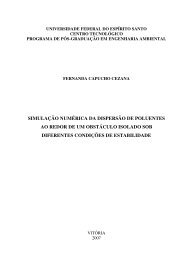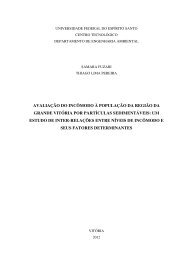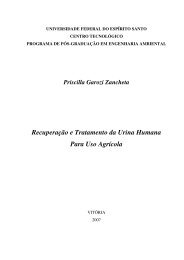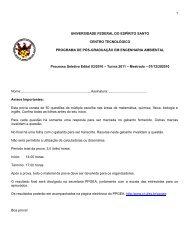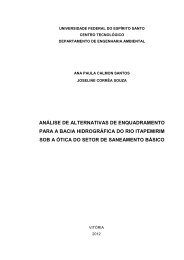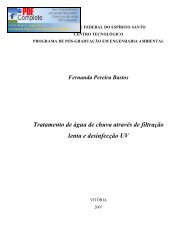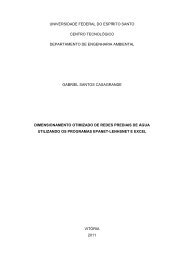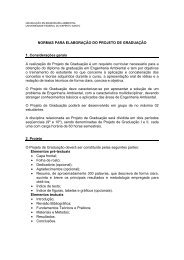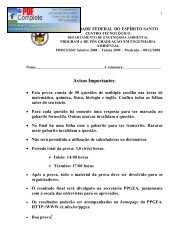PROVA ENG AMB MESTRADO - Centro Tecnológico / UFES
PROVA ENG AMB MESTRADO - Centro Tecnológico / UFES
PROVA ENG AMB MESTRADO - Centro Tecnológico / UFES
Create successful ePaper yourself
Turn your PDF publications into a flip-book with our unique Google optimized e-Paper software.
<strong>UFES</strong> / CCHN / DLL – CURSOS DE LÍNGUAS PARA A COMUNIDADE<br />
PROGRAMA DE PÓS-GRADUAÇÃO EM <strong>ENG</strong>ENHARIA <strong>AMB</strong>IENTAL<br />
CERTIFICAÇÃO DE PROFICIÊNCIA EM LINGUA INGLESA<br />
<strong>MESTRADO</strong> EM <strong>ENG</strong>ENHARIA <strong>AMB</strong>IENTAL<br />
INSCRIÇÃO Nº XXXXXX<br />
HABILIDADE: LEITURA<br />
De acordo com as informações dos textos, responda as perguntas seguintes:<br />
TEXTO 1 EFFECT OF POLLUTION ON GROUNDWATER<br />
A popular misconception is that all water that moves through the soil will be purified “naturally” and<br />
will emerge from the ground in a pristine condition. Unfortunately, there are limits to what soil can<br />
remove, and groundwater pollution is becoming an increasing concern throughout the world.<br />
The agricultural community is becoming more aware of the connection between agricultural<br />
practices and groundwater pollution. Many states have begun working with dairy owners and<br />
farmers to develop farm management plans that restrict fertilizer applications to periods of active<br />
plant growth, which helps prevent groundwater pollution by sequestering nitrate into growing<br />
vegetation. These farm plans also include surface water pollution prevention techniques such as<br />
restricting animal access to stream banks, setting maximum animal density goals, requiring<br />
manure-holding ponds, and revegetating riparian (stream side) areas.<br />
Other potential sources of groundwater pollution include leaking underground storage tanks, solid<br />
waste landfills, improperly stored hazardous waste, careless disposal of solvents and hazardous<br />
chemicals on ground surfaces, and road salts and deicing compounds. Many of the current U.S.<br />
Superfund sites (see Chap. 17, “Solid and Hazardous Waste Law”) are concerned with the cleanup<br />
of materials that have contaminated, or have the potential to contaminate, groundwater.<br />
QUESTÃO 1<br />
Que ideia popular e errônea é mencionada no primeiro parágrafo?<br />
QUESTÃO 2<br />
O que o Estado e os agricultores vêm fazendo para combater a poluição das águas<br />
subterrâneas?<br />
QUESTÃO 3<br />
Quais são as fontes potenciais de poluição das águas subterrâneas?<br />
TEXTO 2 WASTE PROCESSING AND HANDLING<br />
Waste processing and handling are key concerns as a hazardous waste begins its journey from<br />
the generator site to a secure long-term storage facility. Ideally, the waste can be stabilized,<br />
detoxified, or somehow rendered harmless in a treatment process similar to the following:<br />
Chemical Stabilization. In this process, chemicals are mixed with waste sludge, the mixture is<br />
pumped onto land, and solidification occurs in several days or weeks. The result is a chemical nest<br />
that entraps the waste, and pollutants such as heavy metals may be chemically bound in insoluble<br />
complexes. Asphalt-like compounds form “cages” around the waste molecules, while grout and<br />
cement form actual chemical bonds with the trapped substances. Chemical stabilization offers an<br />
alternative to digging up and moving large quantities of hazardous waste, and is particularly<br />
suitable for treating large volumes of dilute waste. Proponents of these processes have argued for<br />
2



